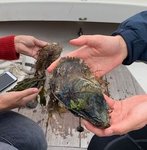
A national initiative to plant more oysters in local waters as a water-quality remedy as well as helping oyster farmers financially is about to launch on Long Island.
The Nature Conservancy and Pew Charitable Trusts have partnered to help struggling oyster farmers impacted by COVID-19 and the economic downturn by purchasing five million surplus oysters and placing them in nearby oyster restoration projects.
The program is called Supporting Oyster Aquaculture and Restoration, or SOAR.
“We’re still waiting to get sites approved by the DEC,” said TNC estuary specialist Adam Starke. “It’s likely a good chunk will happen this fall,” he said. “There’s been an immense reaction from the call.”
Friends of Bellport Bay may be on the list as an oyster recipient; Islip Town farmers may be getting financial help.
“Those are good examples of where they could go,” said Starke.
FOBB co-founder Thomas Schultz, who with co-founder Katia Read planted their one-millionth oyster recently, said he was familiar with SOAR.
“We’ll be zooming on a meeting with Pew soon,” he said. “We support the program, whether we get them or someone else. Our position is, the more oysters on the bay bottom, the better the ecosystem.”
Just one oyster can filter 50 gallons of water a day during their feeding process, Starke pointed out.
Schultz said TNC has already donated scallops to their restoration efforts and Brookhaven Town has been supportive, donating a two-acre bay parcel in July after lobbying for it.
Schultz said FOBB attempted to purchase from overstocked oyster farms on their own after private donors contributed $5,000, but the transfer requires a DEC permit.
“There is a challenge moving oysters to other waters,” Starke noted.
“Right now we’re still in the phase of identifying growers who are interested and the restoration sites that can take oysters. Not every location is perfectly suitable for oysters in general, and we have to do a careful pairing from the farmers to restoration sites and minimize the spread of invasive species like oyster drills—that’s a small snail—and boring sponges that can eat into the shell. So we’re careful about moving oysters around and cleaning them.”
The older oysters TNC would be transporting provide a definite benefit, he emphasized.
“They have more reproductive potential and better cover shells to protect them from predators, so there’s a lot of benefits to a restoration site.”
Starke said restorers would basically pay out of pocket expenses incurred; that is, getting them in the water involving staff and boat time.
Other areas that might be recipients include an aquaculture program the county runs from Peconic Bay to Shelter Island. “There are 50 farms there,” he said.
The idea was initiated in late April; a relief proposal for oyster farmers and marine-related businesses was first pitched to the federal government.
“It didn’t pan out, so we pivoted to private donations,” Starke said.
Aaron Kornbluth, officer at the Pew Charitable Trusts, said through the partnership between Pew and TNC, they were given $5 million by a private donor for the program.
“We believe it will be the largest investment of funding buying oysters and putting them on sites,” Kornbluth said. “About $3 million will go towards purchases during 2020. Next year we hope to launch a $1 million Shellfish Growers Resilience Grant Program. We’ve yet to determine what it will look like, but we want to provide large and small grants around the country.
“We’re hoping the SOAR program can be used as a demonstration to marry environmental and socio-economic ideas.”
Chuck Westfall, president of the Long Island Oyster Growers Association and an owner of Thatch Island Farms and oyster farms on Sexton and Captree islands in Islip Town, commented that the program was helpful and that he was grateful for it, “but the problem is bigger than we can handle.”
“We’re selling half as much at half the price, and the consequence of that is that I and other Long Island oyster farmers are sitting on the highest-quality protein that’s grown sustainably and is environmentally beneficial. We have all this and we can’t get rid of it. I was set to produce a million oysters this year, but it’s less than half now. On my field right now, I can’t move 100,000 in a normal market place.
“As a farmer you really get attached to what you’re doing, and to do something like what we’re up against is heartbreaking.”
In New York, TNC will be working with New York State Department of Environmental Conservation, East Coast Shellfish Growers Association, Long Island Oyster Growers Association and all eligible growers to coordinate delivery of purchased oysters to restoration sites.
Comments
No comments on this item Please log in to comment by clicking here